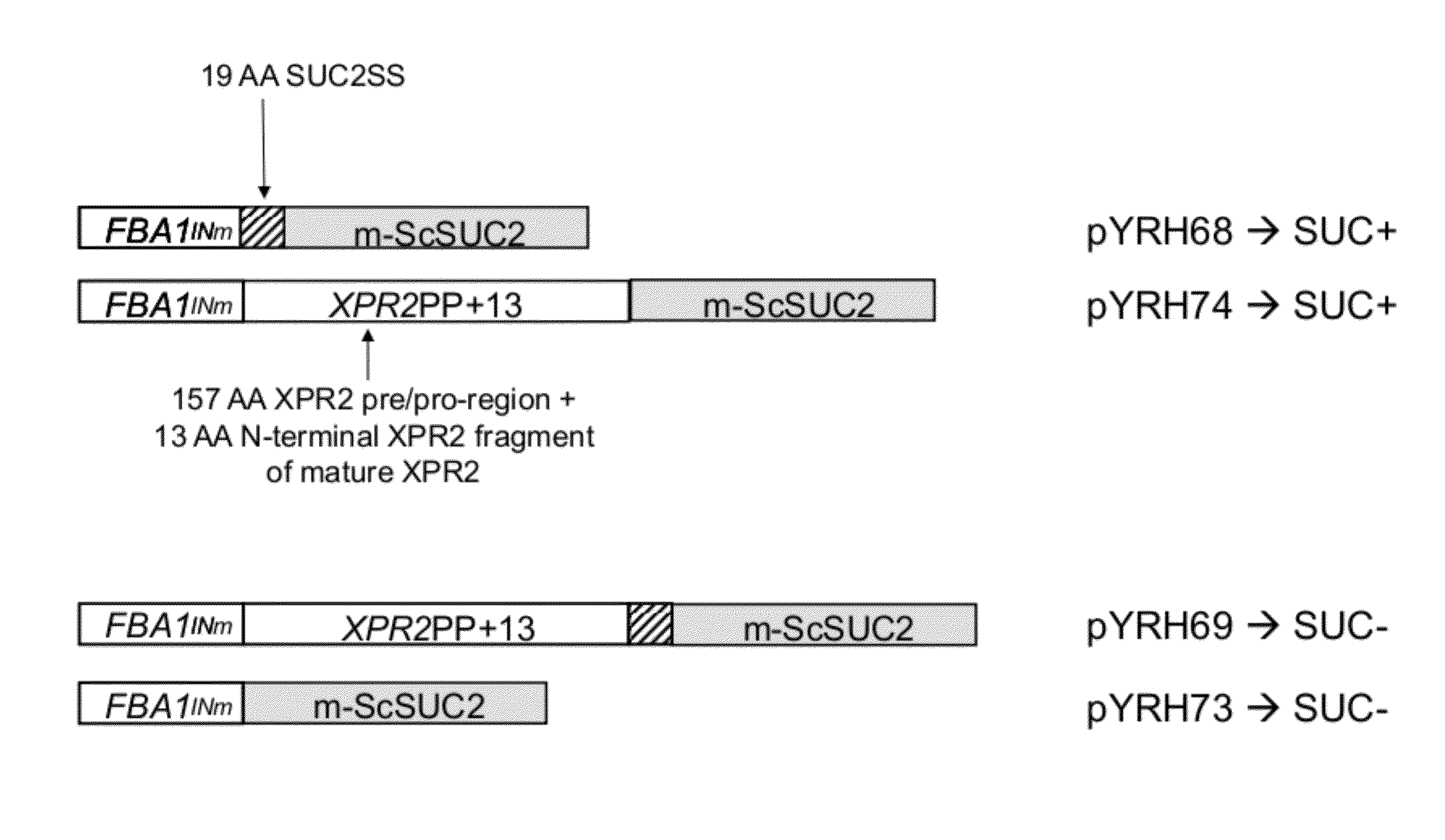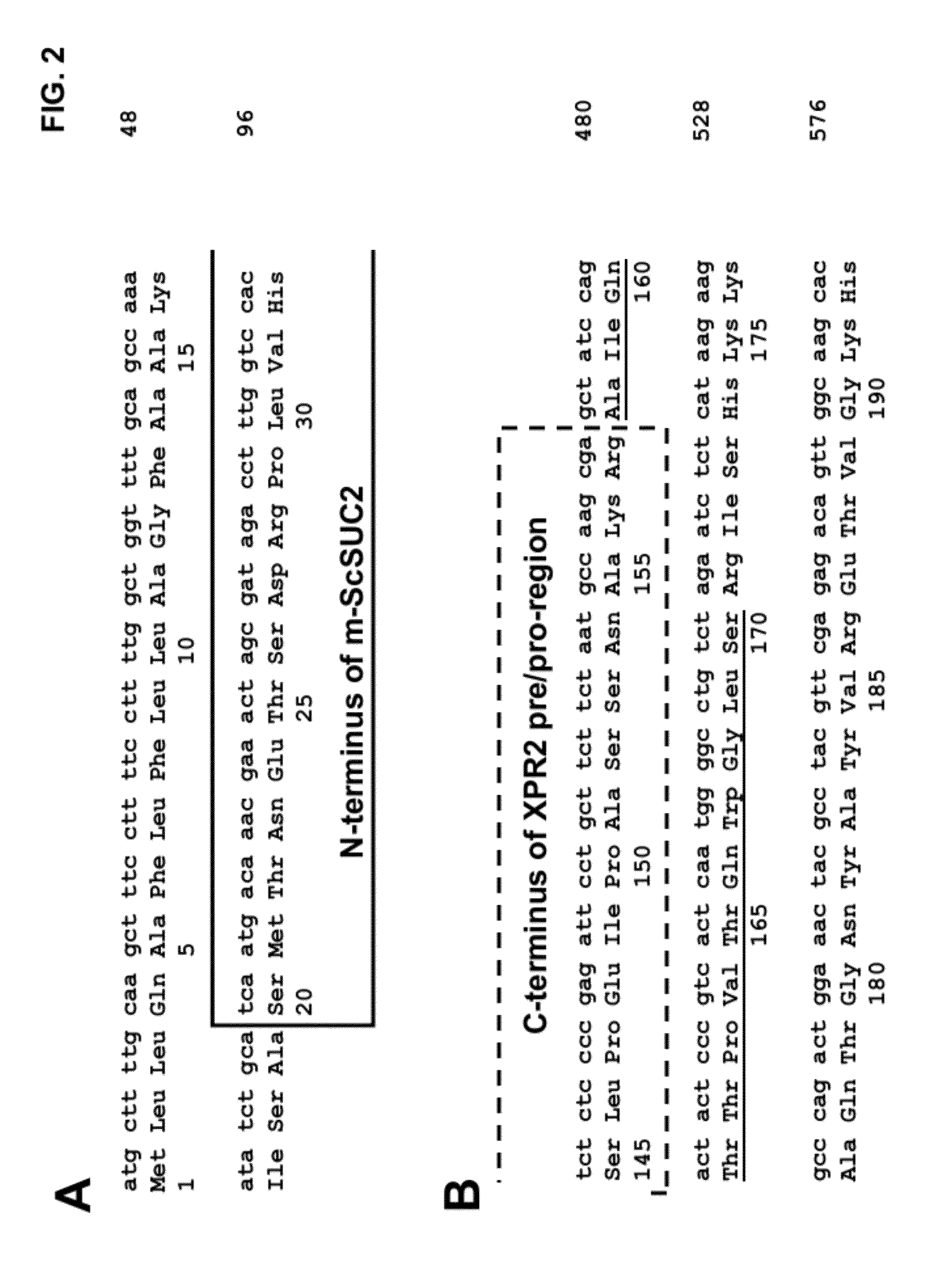Use of saccharomyces cerevisiae suc2 gene in yarrowia lipolytica for sucrose utilization
a technology of saccharomyces cerevisiae and sucrose, applied in the field of biotechnology, can solve the problems of large amounts of natural extracellular secretion, lipolysis and the substrate is not always the most cost-effective carbon sour
- Summary
- Abstract
- Description
- Claims
- Application Information
AI Technical Summary
Benefits of technology
Problems solved by technology
Method used
Image
Examples
example 1
[0174]Construction And Expression Of Yarrowia lipolytica Extracellular Invertase Expression Plasmid pZSUC
[0175]The present Example describes the construction of plasmid pZSUC (SEQ ID NO:22) comprising a fusion of the XPR2 promoter and signal sequences to a truncated variant of the Saccharomyces cerevisiae SUC2 [“m-ScSuc2”] gene encoding invertase, in a manner similar to that reported by Nicaud et al. in Current Genetics (16:253-260 (1989)).
[0176]More specifically, Nicaud et al. reported the secretion of invertase into the periplasm of Y. lipolytica, when expressing the S. cerevisiae SUC2 gene under the control of the promoter and an N-terminal amino acid signal sequence of the Y. lipolytica XPR2 gene. It is stated therein (page 257) that the “fusion puts the 23 N-terminal amino acids from the XPR2 gene in front of invertase, starting at amino acid eleven” (i.e., thus the first 10 amino acids of the full-length invertase were truncated, while amino acids 11-19 of the signal sequence ...
example 2
[0185]Construction Of Yarrowia lipolytica Extracellular Invertase Expression
[0186]Plasmids: pYRH68, pYRH69, pYRH70, pYRH73 And pYRH74 The present Example describes the construction of a series of plasmids comprising various different combinations of the XPR2 prepro-region [“XPR2PP+13”] and / or SUC2 signal sequence [“Suc2SS”] fused to the “mature”Saccharomyces cerevisiae SUC2 [“m-ScSuc2”] gene encoding invertase. The heterologous gene in each construct was flanked by a strong Y. lipolytica promoter (FBAINm; see U.S. Pat. No. 7,202,356) and Y. lipolytica Pex20 terminator sequence.
Construction Of pYRH68, Comprising SucSS / m-ScSUC2
[0187]Plasmid pYRH68 was constructed to overexpress the Suc2 signal sequence (“SucSS”; SEQ ID NO:8) fused to the “mature” ScSUC2 gene encoding invertase (“m-ScSUC2”; SEQ ID NO:4). Effectively, however, this artificial fusion described herein as SucSS / m-ScSUC2 corresponds with the wildtype full-length ScSUC2 gene which naturally contains 5′-signal sequence.
[0188]...
example 3
[0199]Transformation And Expression Of Plasmids pYRH68, pYRH69, pYRH70, pYRH73 And pYRH74 in Yarrowia lipolytica, Grown With Either Sucrose or Glucose as the Sole Carbon Source
[0200]Plasmids pYRH68, pYRH69, pYRH70, pYRH73, and pYRH74 were individually digested with AscI / SphI for transformation into Y. lipolytica strain Y4184U (Example 5) and Y. lipolytica strain Z1978U (Example 6), both genetically engineered to produce significant quantities of EPA % TFAs. Transformants were grown on a variety of media comprising either sucrose or glucose as the sole carbon source.
[0201]Specifically, transformants were first selected on SD media plates lacking uracil (General Methods). Various Y4184U and Z1978U transformant strains were produced, as described below in Table 6.
TABLE 6Y4184U And Z1978 Transformant Strains of Yarrowia lipolyticaOverexpressing Extracellular InvertaseChimeric GenePlasmidExpressed (SEQ ID(SEQ ID NO)NO)Transformants ProducedpYRH68Suc2SS / m-ScSUC2Y4184U + Suc2SS / m-ScSUC2(S...
PUM
| Property | Measurement | Unit |
|---|---|---|
| pH | aaaaa | aaaaa |
| pH | aaaaa | aaaaa |
| pH | aaaaa | aaaaa |
Abstract
Description
Claims
Application Information
 Login to View More
Login to View More - R&D
- Intellectual Property
- Life Sciences
- Materials
- Tech Scout
- Unparalleled Data Quality
- Higher Quality Content
- 60% Fewer Hallucinations
Browse by: Latest US Patents, China's latest patents, Technical Efficacy Thesaurus, Application Domain, Technology Topic, Popular Technical Reports.
© 2025 PatSnap. All rights reserved.Legal|Privacy policy|Modern Slavery Act Transparency Statement|Sitemap|About US| Contact US: help@patsnap.com



